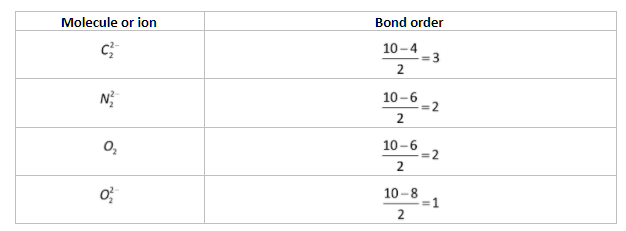
Among the following molecules/ions,
A)
B)
C)
D)
Answer
142.2k+ views
Hint: If a molecule/ion has an unpaired electron then we can say it is paramagnetic, and if it has all paired electrons, then it will be diamagnetic. The bond length of the molecule depends on the bond order of the molecule with an inverse proportional relationship.
Complete step-by-step answer:
We can easily differentiate paramagnetic and diamagnetic molecules or ion on the basis of their electronic configuration. Paramagnetic molecules are attracted to magnetic field because they have unpaired electrons, whereas diamagnetic molecules are repelled by the magnetic field and all the electrons have paired spins.
We can also say that an odd number of electrons can produce paramagnetic ion or molecule and sometimes molecules with even number of electrons may also be paramagnetic such as oxygen molecule. To find out which molecule is diamagnetic or paramagnetic, let us first look at their electronic configuration in accordance with Molecular Orbital Theory.
Electron spin is very important in order to determine the magnetic properties of an atom. In diamagnetic case, all of the electrons are paired up and share their orbital with another electron, due to this their total spin becomes zero as they are aligned in anti-parallel fashion, so the atom becomes diamagnetic.
Now we know that two of them are diamagnetic and the rest two are paramagnetic, let us look at their bond order from their electronic configurations.
Bond order is inversely proportional to the bond length. So, the one which will have highest bond order will tend to have shortest bond length. From the below table, we can see that

We know now that
Note: In case we don’t remember the Molecular Orbital Theory, we can determine experimentally if a substance is diamagnetic or paramagnetic by using Gouy balance. It measures the apparent change in the mass of the substance as it is attracted or repelled by the region of high magnetic field between the poles.
Complete step-by-step answer:
We can easily differentiate paramagnetic and diamagnetic molecules or ion on the basis of their electronic configuration. Paramagnetic molecules are attracted to magnetic field because they have unpaired electrons, whereas diamagnetic molecules are repelled by the magnetic field and all the electrons have paired spins.
We can also say that an odd number of electrons can produce paramagnetic ion or molecule and sometimes molecules with even number of electrons may also be paramagnetic such as oxygen molecule. To find out which molecule is diamagnetic or paramagnetic, let us first look at their electronic configuration in accordance with Molecular Orbital Theory.
Electron spin is very important in order to determine the magnetic properties of an atom. In diamagnetic case, all of the electrons are paired up and share their orbital with another electron, due to this their total spin becomes zero as they are aligned in anti-parallel fashion, so the atom becomes diamagnetic.
Now we know that two of them are diamagnetic and the rest two are paramagnetic, let us look at their bond order from their electronic configurations.
Bond order is inversely proportional to the bond length. So, the one which will have highest bond order will tend to have shortest bond length. From the below table, we can see that

We know now that
Note: In case we don’t remember the Molecular Orbital Theory, we can determine experimentally if a substance is diamagnetic or paramagnetic by using Gouy balance. It measures the apparent change in the mass of the substance as it is attracted or repelled by the region of high magnetic field between the poles.
Latest Vedantu courses for you
Grade 11 Science PCM | CBSE | SCHOOL | English
CBSE (2025-26)
School Full course for CBSE students
₹41,848 per year
EMI starts from ₹3,487.34 per month
Recently Updated Pages
How to find Oxidation Number - Important Concepts for JEE

How Electromagnetic Waves are Formed - Important Concepts for JEE

Electrical Resistance - Important Concepts and Tips for JEE

Average Atomic Mass - Important Concepts and Tips for JEE

Chemical Equation - Important Concepts and Tips for JEE

Concept of CP and CV of Gas - Important Concepts and Tips for JEE

Trending doubts
JEE Main 2025 Session 2: Application Form (Out), Exam Dates (Released), Eligibility, & More

JEE Main Exam Marking Scheme: Detailed Breakdown of Marks and Negative Marking

JEE Main 2025: Derivation of Equation of Trajectory in Physics

Electric Field Due to Uniformly Charged Ring for JEE Main 2025 - Formula and Derivation

Types of Solutions

Learn About Angle Of Deviation In Prism: JEE Main Physics 2025

Other Pages
JEE Advanced Marks vs Ranks 2025: Understanding Category-wise Qualifying Marks and Previous Year Cut-offs

JEE Advanced 2025: Dates, Registration, Syllabus, Eligibility Criteria and More

NCERT Solutions for Class 11 Chemistry Chapter 5 Thermodynamics

Hydrocarbons Class 11 Notes: CBSE Chemistry Chapter 9

JEE Advanced Weightage 2025 Chapter-Wise for Physics, Maths and Chemistry

NCERT Solutions for Class 11 Chemistry In Hindi Chapter 1 Some Basic Concepts of Chemistry




